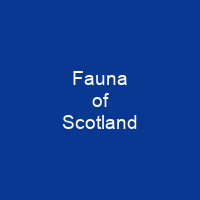The fauna of Scotland is generally typical of the northwest European part of the Palearctic realm. Scotland has more than 90% of the volume and 70% of total surface area of fresh water in the United Kingdom. Conservation agencies are concerned that climate change, especially its potential effects on mountain plateaus and marine life, threaten much of the fauna.
About Fauna of Scotland in brief

Scotland was entirely covered in ice during the Pleistocene glaciations. As the post-glacial weather warmed and the ice retreated, mammals migrated through the landscape. However, the opening of the English Channel prevented further migrations, so mainland Britain has only two-thirds of the species that reached Scandinavia. About 14% of Scotland’s land is wooded, much of it in forestry plantations, but before humans cleared the land it supported much larger boreal Caledonian and broad-leaved forests. Caithness and Sutherland have one of the world’s largest and most intact areas of blanket bog, which supports a distinctive wildlife community. Seventy-five per cent of Scotland’s land is classed as agricultural while urban areas account for around 3%. The coastline is 11,803 kilometres long, and the number of Islands with terrestrial Vegetation is about 800, with about 600 lying off Scotland”s west coast, including the Hebrides and the Orkney archipelago. The country has internationally significant nesting grounds for seabirds such as the northern gannet. Inland, nearly 400 genetically distinct populations of Atlantic salmon live in Scottish rivers. Of the 42 species of fish found in the country’s fresh waters, half have arrived by natural colonisation and half by human introduction. Only six amphibians and four land reptiles are native in Scotland, but many species of invertebrates live there that are otherwise rare in the U.K.
You want to know more about Fauna of Scotland?
This page is based on the article Fauna of Scotland published in Wikipedia (as of Nov. 05, 2020) and was automatically summarized using artificial intelligence.







